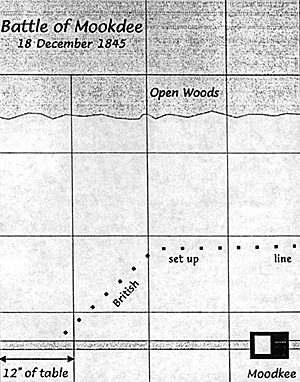 The Battlefield
The Battlefield
The Sikh positions at Moodkee had been carefully selected for creating a battle on the Sikh's terms. The British, after marching 21 miles during the day, were establishing camp in an area of open ploughed fields, near the village of Moodkee. The Sikh "corps" was concealed along a low thorny "jungle." There was no dominating high ground, and aside from the thorny underbrush of the jungle, no large stands of trees. The village of Moodkee was a good defensible position, but could contain no more than a fraction of the army.
The Historic Battle
Late in the day, the British cavalry belatedly detected the Sikh force, while camp was being established. Though surprised, Gough had sufficient warning to form the troops into a line of battle, while the Sikh artillery conducted a desultory long range bombardment. With sunset only a few hours away, Gough decided to take the offensive. He ordered the cavalry under White and McTier to strike at the flanks of the Sikh formation.
McTier's brigade succeeded in driving the Sikh cavalry on the British left flank off into the jungle. It was White's brigade that achieved fame this day. The brigade moved forward, with the 3rd Light Dragoons executing a perfect charge that broke through the flank cavalry, faced right, and then proceed to charge the right flank of the artillery line and the supporting infantry. The dragoons made a proper mess of the Sikh center, getting in amongst the artillery and infantry, and capturing a a Sikh unit's colors. The 3rd Light Dragoon's charge was so brutally effective that in future battles the Sikhs referred to the 3rd as the "Children of Satan."
Following this, the cavalry withdrew, again pushing aside the Sikh horse. Meanwhile, the infantry advanced, regular regiments leading the Company's native regiments. Though the regulars of Harry Smith's division charged with elan, many of the native regiments faltered, failing to support the attack. The 50th Foot and 31st Foot carried the charge home, and in confused fighting in the gathering dusk, overran the Sikh artillery. Unfortunantely for General Gough, this success coincided with the arrival of night, which effectively ended the battle, though scattered fighting took place for the next few hours. The surviving Sikh troops withdrew to the west toward their comrades at Ferozeshah.
Terrain
The battlefield has some unusual terrain which should be treated as follows: Moodkee is represented by a single village base, as described in the rules; Jungle (Low, thorny growth, with a few scattered trees), concealment from view to stationary troops; Ploughed fields, very open terrain, with no cover (treat this as standard open terrain).
Game Length
The game begins with the 3 pm turn and continues through the 6 prn turn, a total of 4 game turns. The British move first.
Victory
The main British objective is to defeat the Sikh force and secure the British camp. The Sikhs are defending the approach to Ferozeshah and the main Sikh army, and attempting to ambush the British Force approaching from Ludhiana.
The British win by destroying or crippling the Sikh Army. The Sikh Army has three "divisions." Each division exhausted at the end of the game counts as one point for the British, while each division in morale collapse or completely destroyed counts as two points. The British win a tactical victory with 4 points and a strategic victory with 6 points.
Sikh Deployment
The Sikh's deploy their entire corps on the table. The Heavy Artillery is deployed within 3" of the edge of the jungle facing the British. The infantry begins the game deployed immediately behind the artillery battalions, with "brigades" in line formation. The Ghochurra cavalry units are deployed on each flank of the main body, within 12" of the respective flank.
British Deployment
The British deploy their entire corps on the table, as noted on the map. White's cavalry is deployed on the British right flank, followed by Smith's Division, Gibert's Division, McCaskill's Division, with McTier's Brigade on the British left flank. The British artillery may deploy anywhere along the British line, within the interior flanks of the cavalry brigades.
The British Army
General Hugh Gough (army
commander)
Foot artillery battalion (2-6)
Horse artillery battalion 1/2 strength
(1 -6)
- White's Cavalry (exhaustion = 2)
Brigadier White (commanding)
- White's Brigade (2-7)
McTier's Brigade (2-6)
horse artillery battalion (2-6)
horse artillery battalion (2-6)
Smith's Division (exhuastion = 6) Sir Harry Smith (commanding)
- Wheeler's Brigade
- 50th (Queen's Own) Foot (2-6)
42nd Bengal Native Infantry (2-3)
48th Bengal Native Infantry (2-3)
Boulton's Brigade
- 31st
(Huntingdonshire)
Foot (2-6)
24th Bengal Native Infantry (2-3)
47th Bengal Native Infantry (2-3)
Gilbert's Division (exhaustion = 3) Major General Sir Walter Gilbert (commanding)
- 2nd Bengal Grenadiers (2-4)
16th Bengal Grenadiers (2-3)
45th Bengal Native Infantry (2-3)
McCaskill's Division (exhaustion= 3) Brigiadier John McCaskill (commanding)
- 9th (East Norfolk) Foot (2-6)
26th Bengal Native Infantry (2-3)
73rd Bengal Native Infantry (2-3)
The Khalsa
General Lail Singh commanding
Artillery Battalion (2-7)
Artillery Battalion (2-7)
Infantry Derah (exhaustion = 4) unknown Singh #2 (commanding)
- Infantry Regiment (3-6)
Infantry Regiment (3-6)
Cavalry Regiment (2-5)
Ghochurra cavalry -right flank (exhaustion = 4) (unknown Singh # 3 commanding)
- 4x Ghochurra skirmisher cavalry
(1-2)
Ghochurra Cavalry (2-2)
Ghochurra Cavalry (2-2)
Ghochurra Cavalry (2-2)
Ghochurras cavalry -left flank (exhaustion = 4) (unknown Singh # 4 commanding)
- 4x Ghochurra skirmisher cavalry
(1-2)
Ghochurra Cavalry (2-2)
Ghochurra Cavalry (2-2)
Ghochurra Cavalry (2-2)
More Sikh War: NW Frontier Conflict 1845 (# 30)
Back to The Herald 31 Table of Contents
Back to The Herald List of Issues
Back to MagWeb Master Magazine List
© Copyright 1999 by HMGS-GL.
This article appears in MagWeb (Magazine Web) on the Internet World Wide Web. Other military history articles and gaming articles are available at http://www.magweb.com